Famed wandering wolf may have found love, say wildlife officials
Loading...
| Portland, Ore.
An Oregon wolf which became the subject of a documentary after making a monumental trek from Oregon to California and back may have finally found what he's been searching for: love.
Oregon wildlife officials said on Tuesday they believe the gray wolf, dubbed OR 7 because he was the seventh wolf collared for tracking in 2011, may have found a mate. If the pair have pups, it would be the first known wolf breeding in the Oregon Cascades since the early 20th century.
OR 7 became well known when he traipsed into California in December 2011, making him the first known wild wolf in the state since 1924. He traveled more than any of the seven wolves collared, making him a celebrity and the focus of a documentary being made to track his progress, Wolf OR 7 Expedition.
"I think it brings awareness of the issue of recovery of an endangered species, especially with the potential for his finding a mate and possibly having a family," said Elizabeth Materna, public affairs specialist for the U.S. Fish and Wildlife Service, Oregon Fish and Wildlife Office.
Since March 2013, OR 7 has spent most of his time in the southwestern Cascades of Oregon.
"He hasn't been wandering as far, he's been more localized," Materna said. "That gave (an) indication he may be with a partner."
Biologists also found images on a camera set up to track OR 7 that showed what appeared to be a black female wolf.
"More localized GPS collar data from OR 7 is an indicator that they may have denned," Fish and Wildlife Service wolf biologist John Stephenson said in a statement. "If that is correct, they would be rearing pups at this time of year."
Officials likely won't know for sure until June if pups are in the picture because they don't want to disturb them at a young age. Pups are typically born in mid-April.
OR 7 was born into northeast Oregon's Imnaha wolf pack in April 2009. Since 1995, the wolf population in Oregon has increased from zero to approximately 64. The gray wolf was listed in 1973 as an endangered species in the United States and remains protected by state and federal laws.
(Editing by Cynthia Johnston and James Dalgleish)





